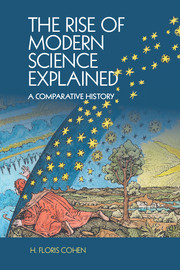Book contents
- Frontmatter
- Contents
- Introduction: the Old World and the New
- 1 To begin at the beginning: nature-knowledge in Greece and China
- 2 Islamic civilisation and medieval and Renaissance Europe
- 3 Three revolutionary transformations
- 4 A crisis surmounted
- 5 Expansion, threefold
- 6 Revolutionary transformation continued
- Epilogue: a look back and a look ahead
- Timeline 1: pre-1600
- Timeline 2: 1600–1700
- A note on the literature
- Provenance of quoted passages
- Index
4 - A crisis surmounted
Published online by Cambridge University Press: 05 March 2016
- Frontmatter
- Contents
- Introduction: the Old World and the New
- 1 To begin at the beginning: nature-knowledge in Greece and China
- 2 Islamic civilisation and medieval and Renaissance Europe
- 3 Three revolutionary transformations
- 4 A crisis surmounted
- 5 Expansion, threefold
- 6 Revolutionary transformation continued
- Epilogue: a look back and a look ahead
- Timeline 1: pre-1600
- Timeline 2: 1600–1700
- A note on the literature
- Provenance of quoted passages
- Index
Summary
In 1608, Hans Lippershey, a Dutch optician, placed a concave and a convex lens a certain distance apart and enclosed them inside a tube. With the concave lens held up to the eye, distant objects looked larger and nearer, and you could even see things too far away for the naked eye. News of the invention spread quickly and reached Padua in the summer of 1609. The professor of mathematics, Galileo, was one of only two people (Thomas Harriot was the other) to whom it occurred to point the tube with lenses at the skies.
Galileo's idea was far from obvious. We at present take it for granted that the natural world is full of things which are invisible to the naked eye, from the cells in our bodies to the star-studded Milky Way set in infinite space. To observe such things one needs instruments, of a kind that did not then exist. The instruments which did exist were able to support observations and calculations – Tycho Brahe had refined them to the highest degree – but they did nothing but give greater precision to the recorded properties of objects already known. Nobody could have guessed that the Milky Way, that misty veil lying across the night sky, would on closer inspection dissolve into millions of stars. Nobody could have suspected that Jupiter is orbited by moons, that there are strange appendages on both sides of Saturn or that the surface of the Moon is studded with craters and valleys. All these facts were discovered by Galileo, and their repercussions would extend much further than the immediate sensation they caused throughout Europe when he published them in 1610 in a concise, matter-of-fact and spectacularly illustrated treatise entitled Sidereus nuncius (‘The Starry Messenger’). They were also to have a number of important repercussions for Galileo himself.
In the first place, they gave him the opportunity to get away from Padua. The previous eighteen years of experimenting, reasoning and checking had laid the foundations for a radically new mode of realist-mathematical nature-knowledge. He was entirely convinced of its superiority over any current philosophy of nature. He now saw himself as a ‘mathematical philosopher’. Not that this was a recognised social role: there were mathematicians and there were philosophers, but in between yawned a wide gulf.
- Type
- Chapter
- Information
- The Rise of Modern Science ExplainedA Comparative History, pp. 145 - 182Publisher: Cambridge University PressPrint publication year: 2015



